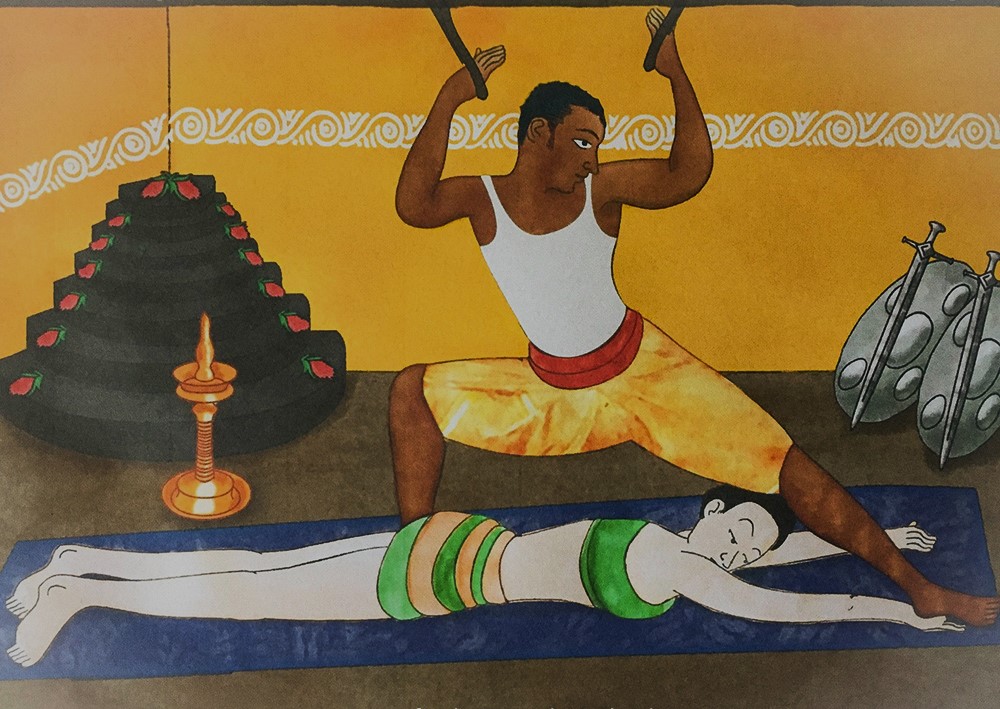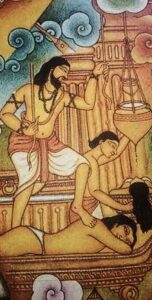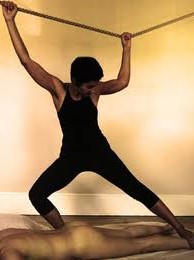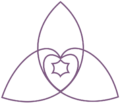Chavutti Thirumal
massage of the Keralite warrior

“…These youths were first smeared all over with oil and ghee mixed with other substances and laid prostrate on the ground. Then the training master, firmly holding in his hand a rope hung downward from the roof, gently rubbed the student’s body with his feet until every available inch of it felt its easy sliding touch. The process is continued for one or two hours, and after having been subjected to it for some days, the body becomes quite lissome…”
Gopala Panikkar, 1929

When I started my massage journey in 2020, I received many different forms of massage. Far and away the most transformational massage I experienced has been Chavutti Thirumal. Chavutti is a complete ‘ironing out of body and mind’ and energetic renewal. It remains my ‘go-to’ massage to receive.
For me, massage is not just about relaxation, but is part of a regime of healing and personal growth. The two other strands of massage I specialised in – clinical massage and Lomi Lomi – are also powerful experiences of the healing and wholeness that massage brings. Chavutti is a healing practice for Kalari martial artists and dancers, and is linked closely to ayurvedic medicine and its philosophy of health. From my own experience, I knew that it would bring both physical and energetic depth to what I offered my clients.
Massage for martial artists and dancers
Chavutti is an integral part of the training, conditioning, healing and general health system of Kalaripayattu, an ancient martial arts practice which originated in Kerala, Southern India. ‘Kalari’ means ‘gymnasium’ – the place where you learn and train – and ‘payattu‘ means warriors. It was not just warriors who trained in the Kalari, but also artists and dancers. Massage was as integral to the dancers’ regime as the warriors’, as both needed massage to execute these dynamic practices and heal from inevitable injuries that they incurred.

Chavutti Thirumal literally means ‘massage by feet’ and is one of a range of massages practiced in the Kalari. Of these, Chavutti is the firmest and most extreme, but it is also the one that brings maximum relief to the receiver. In practice, the amount of pressure is adapted to the receiver and what they can manage. Receivers lie on the floor and, using ropes to balance, the practitioner sweeps over the whole length of the body adjusting the pressure as necessary. Although the feet allow a greater range of pressure to be used, use of the feet also enables a stretching of the muscles, joints and tissues which is difficult to achieve with hands and forearms alone.
The benefits

The benefits of Chavutti are manifold. It promotes a general healthy constitution, it restores proper blood circulation and removes excess fat. It increases nimbleness, flexibility and suppleness of the body. It facilitates all the twisting and manoeuvring of the body needed in martial arts, dance and in sports in general, but is of benefit for anyone of any age and physical condition in living an active and dynamic life.
All massage promotes the above benefits to a greater or lesser extent, but with Chavutti there is “maximum pressure, maximum effect”. Although very good for deep tissue and those who like to ‘feel the depth’ of a massage, Chavutti is an energetic and enlivening treatment, and a lighter treatment can also be hugely beneficial.
In the video below, mention is also made on the ‘beautifying effect’ of Chavutti…
Energetic work and the use of ayurvedic oils
There is an obvious ‘physiological’ dimension to Chavutti. However, like its cousin Thai massage, Chavutti is based on the eastern understanding of the subtle energetic meridians of the body, and in the Eastern mind it is really the energy flow, or lack of, that promotes or detracts from the health of the body and mind. Although Thai massage and Chavutti look very different, both are about balancing the energy of the body and it is this that brings health and wellness.
The oils used in Chavutti are important. It can be performed using plain, ‘carrier’ oils (like organic sesame or coconut) to great effect, but usually oils infused with the natural herbs of ayurvedic medicine are used. Covering the body in ayurvedic oils can be viewed as a treatment in itself and work independently of the physical strokes applied. There are a variety of ayurvedic oils commonly used in Chavutti, each with different healing properties. There are oils which relax sore muscles after exercise routines, strengthening and rejuvenating them, oils for chronic joint and muscle pains, cramps, dislocations, arthritis, sprains, inflammation, nerve discomfort to name but a few. In short, these oils can aid recovery from a number of both acute and chronic conditions.
I have been extremely fortunate to have such an experienced Chavutti therapist in Candida Valentino so close to where I live, and it is through Candida that I have trained. She has been practicing Chavutti since 1996, training in and studying its associated medicine with the Yoga Therapy Institute in Trivandrum, and with Dhanurveda and VKM Kalariafter in Thrissur, both in Kerala, a region which is an important centre of Ayurvedic medicine. Read more about Candida at soundtransformations.co.uk.

